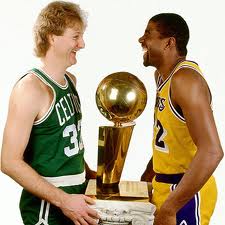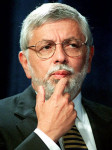 (Readers: This column originally ran during the NBA Finals. It is especially pertinent now that the NBA is switching back to 2-2-1-1-1.-CS)
(Readers: This column originally ran during the NBA Finals. It is especially pertinent now that the NBA is switching back to 2-2-1-1-1.-CS)
The most important playoff series in NBA scheduling history — the one that changed the NBA Finals from a 2-2-1-1-1 format to the current 2-3-2 — began easily enough.
The leisurely pace of the first four games would get lost in the frenzy of the last three, but travel was not an issue the first 11 days of the 1984 NBA Finals between the Boston Celtics and Los Angeles Lakers.
That’s how long it took — 11 days — to play four games. The NBA was only three years removed from having the Finals on tape delay during primetime, so the reality was that if league executives wanted their games to be televised live, they would play exactly when CBS told them to play. And CBS did not want a game in prime time during the crucial “sweeps” period when ratings were determined and advertising rates were set because unlike now, when even “low-rated” games are the most watched on TV, those games were no contest to primetime schedules.
So that meant Game 1 was played on Sunday but Game 2 was not until Thursday. There was some general griping from the print media about the schedule because the news could be covered in one day but stories had to be written for three days.
But the good news was that after the work day ended, the fine restaurants and provocative nightlife of Boston could be enjoyed with the healthy newspaper industry kind enough to foot the bill.
Between Games 1 and 4, there were always at least two days off. So even though one of those days was spent flying from the East Coast to the West Coast after Game 2, it was still an easy pace.
But as the first series between the Lakers and Celtics since Bill Russell and John Havlicek vs. Jerry West and Wilt Chamberlain in 1969 progressed, the games got feistier and more fascinating.
The Lakers shocked the Celtics in the opener at Boston Garden and suddenly had the home court advantage.
In Game 2, the Lakers had the ball for the last shot, but Magic Johnson was uncharacteristically indecisive late in the game in regulation time and dribbled out the clock with the score tied. In overtime, Gerald Henderson stole a lazy pass made by James Worthy, scored a layup with 18 seconds left and the Celtics evened the series with a victory.
After the Celtics lost Game 3 in Los Angeles by 33 points, Larry Bird said Boston played “like sissies.”
That led to the infamous Kevin McHale takedown of Kurt Rambis in Game 4 and when that contentious game ended with a Celtics victory, the series was 2-2.
Everyone knew what came next – a possibility of three cross-country plane trips in five days. The best-case scenario was one team would win two consecutive games and the series would be over. But no one – coaches, players, writers, NBA executives – was looking forward to the travel. It was going to be a nightmare.
 One writer – no names mentioned – was dreading the travel so much, in fact, that he distinguished himself after Game 4 when he called his editor and suggested not making the trip to Boston. “No one can win the series in Game 5 and we’ll save the money from two cross-country flights,” he reasoned. He understood that two key words for any sports editor would be “save” and ”money.” So while the NBA Finals entourage went en masse to Boston, this guy stayed at his LA hotel and covered Game 5 from his TV. He was ridiculed – and envied.
One writer – no names mentioned – was dreading the travel so much, in fact, that he distinguished himself after Game 4 when he called his editor and suggested not making the trip to Boston. “No one can win the series in Game 5 and we’ll save the money from two cross-country flights,” he reasoned. He understood that two key words for any sports editor would be “save” and ”money.” So while the NBA Finals entourage went en masse to Boston, this guy stayed at his LA hotel and covered Game 5 from his TV. He was ridiculed – and envied.
The thing that everyone feared – and welcomed – happened and it sparked a change that has lasted 29 years. The series went the full seven games and the travel was brutal.
But the basketball was sensational, which was a tribute to the greatness of the players.
At the time, there was no such thing as team charters, so the players flew commercial. In fact, on two of the flights from LA to Boston, the Celtics occupied the first class section of the jumbo jet and a large contingent of the media, including members of the CBS broadcast crew, were on the same plane in coach.
The flight took almost six hours. Add that to the three-hour difference in time zones and the day disappeared. Each day of travel was followed the next day by a game. It was not an ideal way for a championship to be decided.
Still, the quality of basketball was remarkably high, in no small part because both teams were blessed with youthful energy. Bird was 27 and Magic was 24 at the time and even Kareem Abdul-Jabbar was a spry 37 (and averaged 23.9 points and 36.5 minutes a game during the playoffs).
The series went to a dramatic seventh game, which Boston won, and while the overall series was scintillating, there was no reason to leave such a flawed system in place. So youthful commissioner David Stern decided a kinder and gentler schedule was needed and the format was changed to 2-3-2.
 If you compare the circumstances that existed then with now, there is no reason for the NBA to not switch back to the 2-2-1-1-1 format. The most obvious is that if it’s good enough to be used for the first three rounds of the playoffs, it should be used for the most important round.
If you compare the circumstances that existed then with now, there is no reason for the NBA to not switch back to the 2-2-1-1-1 format. The most obvious is that if it’s good enough to be used for the first three rounds of the playoffs, it should be used for the most important round.
Even though the format will not have an effect on the current Finals, it could have. Had the Spurs won Game 4, they would be in position to win the title tonight on their home court.
In the regular season, the Heat won the home court advantage. There should never be a time in a playoff series when a team that has home court advantage and has won every home game is behind in he series. Yet under the 2-3-2, if both teams hold home court, after five games the team that does not have the home court advantage will lead 3-2 in the series.
ABC analyst Jeff Van Gundy has been outspoken during the series about changing the format. Obviously the situation is vastly different than it was in 1984. Team charters make travel much easier. The NBA is in position to work with ABC on the television schedule.
Right now it seems the NBA uses the 2-3-2 system only because that’s the way it has been done for 29 years.
There were very good reasons to change the system after the 1984 Finals, although, looking back, that certainly ranks as one of the greatest championship series in NBA history.
But the reasons no longer exist. It’s time to go back to the past. It will make the future much better.
CHECK OUT JAN HUBBARD’S ARCHIVE FROM SHERIDAN HOOPS.COM. TERRIFIC STUFF ON THE NBA, PAST AND PRESENT.
Jan Hubbard has written about basketball since 1976 and worked in the NBA league office for eight years between media stints. Follow him on Twitter at @whyhub.
Hi there! This post couldn’t be written any better! Going through this post reminds me of my previous roommate!
He constantly kept preaching about this. I will send this article
to him. Fairly certain he will have a great read. Many thanks
for sharing!
I take it the author means that if San Antonio won the series in five games, three of those games would have been played in San Antonio and only two in Miami. In the 2-2-1-1-1 format, there is never a point in the series where more games have been played on the home court of the team that lacks home court advantage. In the 2-3-2 format, by contrast, a series ending in five games in effect confers home court advantage on the home court disadvantaged team.
Got it. Thanks for the clear explanation, that makes sense now.
I agree that the format should go back to 2-2-1-1-1, but I’m confused by one of your reasons:
You said that “In the regular season, the Heat won the home court advantage. There should never be a time in a playoff series when a team that won home court advantage does not have home court advantage.”
The Spurs won one of the first two games in Miami, and “stole” home-court. That would also have been the case in a 2-2-1-1-1 format, since a team that steals homecourt in one of the first two games simply has to win their home games and would close out at home in game 6.
The Heat would be in the same situation, having to win one on the road in order to win the series, no matter the format.
That being said — I don’t like 2-3-2 because even for a team that “steals home court” in one of the first two games, they have to win 3 games in a row in order to avoid being forced to win the series on the road. 3 in a row against a team that made it to the finals is a tough task, even if all three are at home. 2-2-1-1-1 really makes for the best series, like the Miami-Indiana one we just witnessed.
Yes, the Spurs stole a game and but the Heat won the game back. In other words, what the author is saying is that the series was tied—as if both teams had just won their home games. Game 5 was in San Antonio. This is a scenario that should never happen because the lesser team has the advantage. It negates the entire regular season.
What I find hilarious is how people are negating the format like it doesn’t matter affect the outcome. Really? OKC was the better regular season team last year, yet Miami stole a game and had three straight in Miami. Dallas beat Miami two years ago. The Heat had home court and they should have had Game 5 in Miami. Instead, Dallas won Game 5 in Dallas to go up 3-2. In the 2006 Finals involving the same two franchises, Dallas had home court and won the first two games. Miami won the next two games to tie the series, then had a pivotal game in their building to go up 3-2.
For whatever reason, opponents of changing the format like to point out that having Games 6 & 7 at home give the better regular season team the advantage. How is it an advantage if you are already playing from behind because the other team had the advantage before you? In other words, in a 2-2-1-1-1 format, the better team has the advantage as they should. In the 2-3-2 format, the lesser team clearly has an advantage. Above all, why do we play the regular season??
Steve, you have made some great points, but please be sure to realize that with the best two years competing, home court does not make that huge of a difference. The best of teams can and should be able to win a road game as no finals in this format has feature the home team winning every game.You mentioned Miami sweeping the middle three games at home twice. Remember also that three teams swept the middle three games on the road in this format so the 2-3-2 really gave the advantage to the team with the home court advantage.